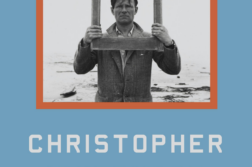 Derek Jarman and Lyric Film: The Mirror and the Sea
Derek Jarman and Lyric Film: The Mirror and the Sea
by Steven Dillon
University of Texas Press
271 pages, $22.95
THE FILMS of Derek Jarman are difficult to categorize. Ethereal, sensual, and for the most part without a clear narrative line, they reflect his varied creative talents and resonate with his ruling passions. In addition to his film work, Jarman was also an accomplished painter, designer, and poet. These interests all played a role in shaping his unique films, as did his interest in an arcane mix of subjects that included Jungian psychology and symbolism, the life and work of Renaissance magus John Dee, and the work of William Blake. Given these rather esoteric influences, one would expect that Jarman’s films would never have found a very large audience, but in fact many of them did, enjoying relatively wide theatrical releases both in his native England and in the USA. A number of them remain popular on video and DVD.
Jarman, who died in 1994 at the age of 52, produced a string of acclaimed feature films that includes The Tempest (1979), Caravaggio (1986) and Edward II (1991), in addition to numerous short films, music videos, and other film projects. He also left behind several unfilmed scripts and a substantial body of writing in the form of journals, a book of poems, essays, and film notebooks. Beyond his creative work, Jarman was also a highly public figure who embraced gay activist causes and was never afraid to speak his mind. This activism also found outlet in such films as The Garden (1990) and Blue (1993), a highly personal rumination on AIDS.
Steven Dillon’s new book is an attempt to explicate Jarman’s creative output—both the films and the other artistic pursuits that informed them—and to do so within the broader context of lyric film. Indeed, Dillon’s primary objective is to set forth a history of lyric film. Jarman’s body of work provides rich material for Dillon’s effort to illustrate the potential of lyric film, which he defines as essentially non-narrative and poetic.
Dillon begins his study by outlining the development of lyric film and establishing a useful historical context. In doing so, he manages to do justice to lesser-known directors and identifies some of Jarman’s early influences. Beginning with the American D.W. Griffith, Dillon establishes what is a crucial link in his explanation of lyric film: the link between poetry and cinema. Noting Griffith’s appreciation of Whitman and his appropriation of the poet’s words in his films, Dillon finds a similar poetic prominence in Jarman’s work. Dillon’s discussion of lyric film also includes little-known directors from the early days of Russian and Armenian cinema, as well as more familiar names such as Jean Cocteau, Jean Genet (who experimented with film), and Atom Egoyan. In addition to examining Jarman’s place in the lyric tradition, Dillon places him squarely within the arena of homosexual cinema.
Before presenting detailed, chapter-length descriptions of Jarman’s individual films, Dillon develops a theory of Jarman’s poetic film imagery that focuses on two central images: the mirror and the sea. Dillon links the former image to both the art of film-making itself and the “doubling” attendant in homosexual desire, and the latter image with the theme of the dissolution of the self. He grounds his discussion in a close reading of Jarman’s early poetry and, in particular, an examination of the picture-poem juxtapositions of Jarman’s only published volume of verse, A Finger in the Fishes Mouth (1972). One wonders if Dillon doesn’t give more attention to these early poems than they warrant, but his analysis is clever, and it leads to a useful paradigm for his discussions of Jarman’s film work, particularly of the queer identity he manifested in his films.
While Dillon’s overall study owes much to a close reading of Jarman’s work, he also draws upon an admirable breadth of scholarship. The author is well-versed in relevant fields such as semiotics, film theory, Jungian psychology, and queer theory, but he is also conversant in the more obscure subject matter essential to an appreciation of Jarman’s imagery. He draws, for example, upon Frances Yates’s seminal studies of the Renaissance occult and Hermeticism. He also makes good use of Tony Peake’s Derek Jarman (2000), a thorough and valuable account of the artist’s life and work.
While Dillon’s examination of Jarman’s work is rigorous and sustained, he continually keeps us mindful of the broader context of lyric film, and of lyric art in general, of which Jarman was such an accomplished practitioner. Dillon’s work is primarily scholarly, but Jarman devotees will appreciate this book’s thorough and careful examination of this important filmmaker’s work.
Jim Nawrocki is a frequent contributor to this journal.






